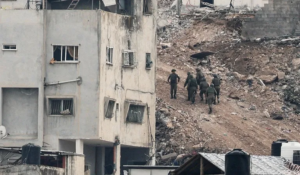Fighting in Jenin shows the Israeli army’s new ethos is clearly ‘shoot first’

Israeli soldiers in Jenin in the West Bank, February 2025
Amos Harel writes in Haaretz on 7 February 2025:
At the beginning of the week, the army released extraordinary footage from Jenin in the West Bank. Forces that had been operating in the city and the refugee camp for three weeks blew up 23 homes at once. The army said they had been used as “terrorist bases.”
The scene looked like something from the Gaza Strip. The destruction that the army is leaving behind in and around Jenin may not reach Gaza proportions, but it’s greater than anything we’ve seen in the West Bank since 2002’s Operation Defensive Shield during the second intifada.
In every announcement, the prime minister, the defense minister and the generals stress the operation’s scope. Some of them mention the intent to deploy troops in Palestinian territory for the long term, a step the military has avoided for many years.
Jenin’s mayor said this week that around 40 percent of the city’s residents had fled because of the fighting. The army announced Tuesday that “55 terrorists have been eliminated,” with 380 suspects arrested. Presumably these numbers have risen.
That day, a Palestinian fired on an army checkpoint near the village of Tayasir, killing two reservists and wounding seven soldiers. The checkpoint is on the road linking the northern Jordan Valley to the area between Jenin and Nablus. The army now has several combat teams in the northern West Bank as part of the operation, which it has dubbed Iron Wall. Cynics in the General Staff are calling it Smotrich’s Wall after far-right Finance Minister Bezalel Smotrich.
The green light for the operation, which coincides with the Gaza cease-fire/hostage deal, is designed to give the far-right parties cover for remaining in the governing coalition. They can argue that the war on terror is continuing unabated, particularly in areas that greatly concern their voters. The operational need in the northern West Bank dovetails with the political need, and the army acts accordingly.
This approach, which the right calls “aggressive,” includes plenty of cruel treatment of Palestinian civilians. It’s also inconveniencing drivers due to the massive array of new checkpoints in the West Bank.
Another component is the legacy of former National Security Minister Itamar Ben-Gvir in the prisons. Prison service officials took pride in their aggressive treatment of Palestinian prisoners who would be released in the hostage deal. Actually, the army had much more responsibility, both in the prisons and in the detention centers.
Hamas’ October 7 atrocities removed the restraints for soldiers and jailers. The long-term result isn’t only stricter prison conditions, there have also been a raft of cases of methodical torture.
The atmosphere of revenge and the army’s approach to the war in Gaza – everything is dangerous so everything is allowed – has spilled over into the West Bank. Some commanders are trying to calm the atmosphere as conscripts redeploy from Gaza to the West Bank. But conversations between reserve officers and the young generation reveal a wild atmosphere, extremism that deems harming Palestinians as settling scores for the massacre.
Soldiers blithely describe entering Palestinian homes at 1 A.M. and throwing stun grenades to show the locals who’s boss. They’re also lax about when and how armed men surrender, and at what point to treat them as prisoners.
It’s hard to argue about one thing. Nine years after then-IDF Chief of Staff Gadi Eisenkot battled to impose restraint after the affair in which Sgt. Elor Azaria killed an incapacitated assailant, it’s clear who won. The Israel Defense Forces of 2025 shoots first and asks questions later, if it asks at all. Motivated by the massacre, the Azaria has ethos won.
Incriminating images
An Israeli security official who recently did a stint in Arab countries noticed something interesting. Broadcasts by Qatar’s Al Jazeera, the most popular television network in the Arab world, linger on photos of Israeli officers and soldiers during coverage of the war.
Al Jazeera lists biographical details alongside every photo: name, unit and role. These broadcasts rely on databases that Palestinian organizations and BDS groups created for the launching of legal proceedings against Israeli soldiers abroad. The efforts by these groups began shortly after the October 7 massacre and ramped up after Israel’s ground invasion into Gaza three weeks later. Various groups have reportedly tried to get career officers and especially reservists arrested during their stays abroad. Some of the information is based on soldiers’ social media posts, particularly when they documented suspected war crimes or lesser offenses.
This article is reproduced in its entirety
